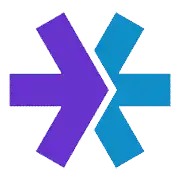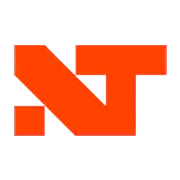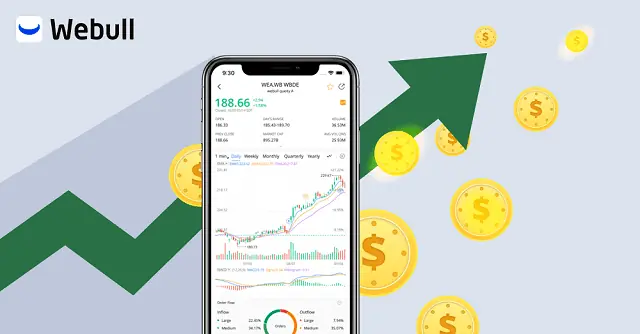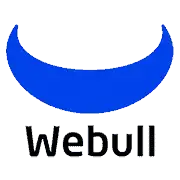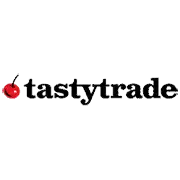Top Platforms for Day Traders:
|
Primary Rating:
3.8
|
Primary Rating:
4.5
|
|
Account minimum: $100. No account fees. Commission rates below.
|
IBKR Lite: Commission-free equity trading. IBKR Pro: Minimal commissions*.
|
Best Leading Broker Day Trader Platform (Runner-Up): E*Trade
Compare the Best Day Trading Platforms
| App | Apple App Store Rating + Best For | Fees | Promotions |
|---|---|---|---|
 Plus500 Plus500 | ☆ No App Store Rating Beginner futures traders | Micro E-mini futures: 49¢ per contract. Standard futures: 89¢ per contract. NFA Regulatory Fee: 2¢ per side, per contract. Auto-liquidation fee: $10 per contract. | None |
 E*Trade E*Trade | ☆ 4.6 / 5 Options traders | No commissions on equity trades | Account bonus commensurate with contributed funds ($50-$6,000 in value) |
 Interactive Brokers Interactive Brokers | ☆ 4.5 / 5 Day traders | Equities: IBKR Pro has fixed rate $0.005/share commissions with volume discounts starting from $0.0035/share with < 300k shares traded/mo. to $0.0005/share with 100m+ shares traded/mo. Futures: Starts at $0.85/contract with monthly volume discounts available when exceeding 1,001 contracts per month. Over 20,000 contracts traded per month costs $0.25/contract | None |
 Robinhood Robinhood | ☆ 4.2 / 5 Beginners | No commissions on equity trades | Bonus stock with signup and linked bank account ($5-$200 value) |
 NinjaTrader NinjaTrader | ☆ 4.2 / 5 Futures and forex traders, beginners looking for free sim trading | Varies by trading needs: Free, $99/mo., or $1,499 one-time payment + data fees may apply | Trade futures commission-free for 30 days, up to $250 in commission rebates* |
 CIBC Investor's Edge CIBC Investor's Edge | ☆ 4.5 / 5 Canadian traders | Varies by security; see full details in product box below | Use promo code EDGE100 to get 100 free online stock and ETF trades when you open a CIBC Investor's Edge account. |
 TradeStation TradeStation | ☆ 4.5 / 5 Advanced traders | No commissions on equity trades | None |
 Moomoo Moomoo | ☆ 4.6 / 5 Advanced traders looking for low margin rates | No commissions on equity trades | 15 bonus stocks (worth $30-$30,000 in total) |
 Tastytrade Tastytrade | ☆ 4.8 / 5 Day traders, futures and options traders | Futures: $1.25 per contract Micro Futures: $0.85 per contract Smalls Futures: $0.25 per contract Smalls Futures Options: $0.50 (opening commission, $0 to close) | $50-$5,000 when making qualifying deposit |
 eToro eToro | ☆ 4.8 / 5 Stock and crypto day traders interested in CopyTrader | No commissions on equity trades | Get $10 when you deposit at least $100 |
 Webull Webull | ☆ 4.7 / 5 Intermediate traders | No commissions on equity trades | 20 bonus stocks with $500 deposit, valued between $60 - $90,000 |
| *Apple App Store Rating as of Aug. 25, 2025 | |||
1. Plus500 (Best for Beginners)
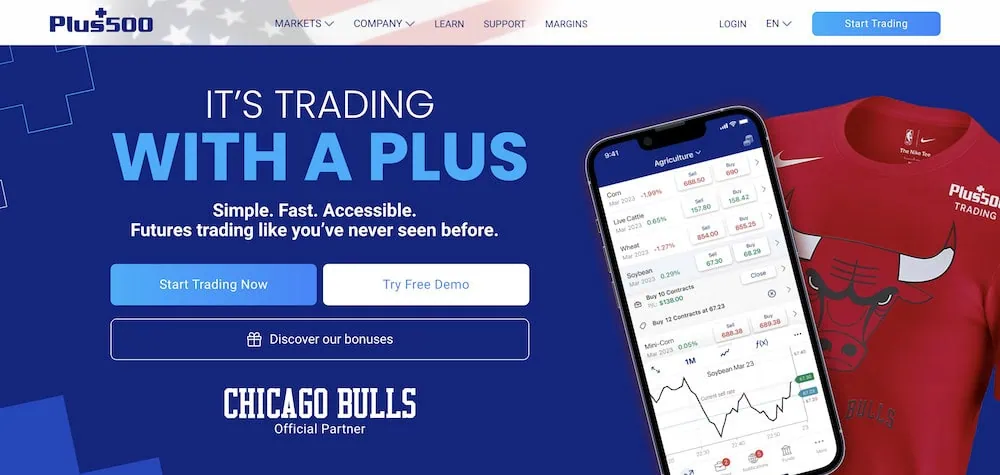
- Available: Sign up here
- Best for: Beginner and intermediate futures traders
- Platforms: Web, mobile app (Apple iOS, Android)
Plus500 is an intuitive, streamlined, and economic way for retail investors to trade futures markets.
Plus500 provides access to futures contracts on equity indexes, forex, metals, agriculture, energy, interest rates, and crypto. And it does so via a platform that’s decidedly tailored for retail investors. Plus500 eschews complex displays and advanced technical tools—admittedly a turn-off for more seasoned individuals and institutional traders—for an uncomplicated, easy-to-use interface.
Traders can open an account with as little as $100, and they’re only charged as they trade—there are no account or market data fees. Commissions are low, as are day trading margins.
Plus500 is particularly friendly to those who are eager to learn. You can sign up for an unlimited free demo that allows you to test out the platform or try out your trade ideas until you’re comfortable enough for the real deal. Meanwhile, Plus500’s Futures Trading Academy includes videos and articles that can build your knowledge of all things future trading, and help you become more familiar with Plus500’s technology.
If you need help, you can contact Plus500, 24/7, via email, live chat, and WhatsApp, and its customer support provides help in 16 languages.
Learn more about the platform or sign up today at Plus500.
- Plus500 is an easy-to-use futures trading platform that provides access to contracts on equity indexes, forex, metals, agriculture, energy, interest rates, and crypto.
- Fair commissions. Micro E-mini futures: 49¢ per contract. Standard futures: 89¢ per contract. NFA Regulatory Fee: 2¢ per side, per contract. Auto-liquidation fee: $10 per contract.
- Learn everything you could want about futures contracts and the platform via Plus500's Futures Trading Academy, as well as its unlimited free demo.
- Special offer: Receive up to $200 when you make an initial deposit.*
- No account fees
- Low commissions
- Low margins
- Unlimited free demo
- Wealth of educational resources
- No advanced trading tools.
- Required account minimum ($100)
- Can only trade futures
2. Power E*Trade + E*Trade Pro (Best for Options Traders)
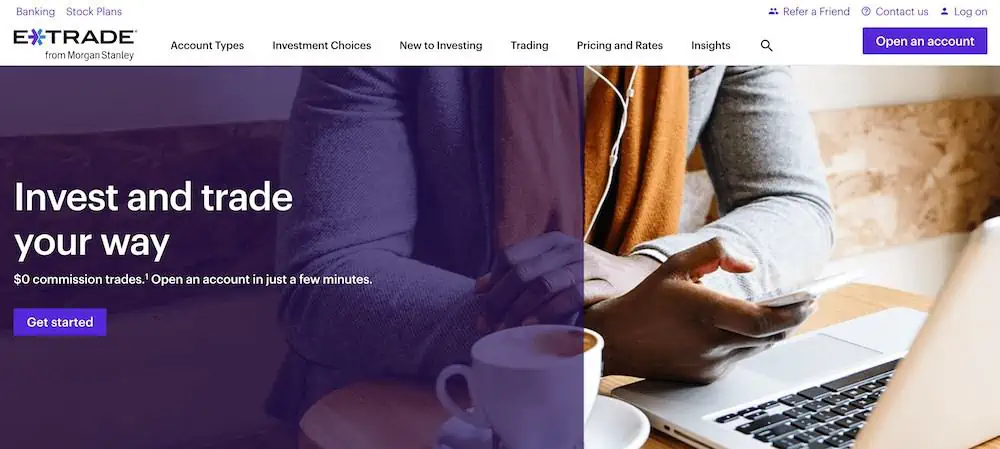
- Available: Click “Open Account” Below
- Best for: Intermediate-to-advanced traders
- Platforms: Web, mobile app (Apple iOS, Android)
E*Trade has long been seen as a leading stock investment app for retail investors. E*Trade provides investors access to educational resources that assist you with conducting investment research and analysis and diversifying your portfolio.
E*Trade, like most of the best stock investing apps, offers zero-commission stock, ETF, and options trading. It also has a leg up on some platforms by offering $0-commissions on trades of mutual funds. Options still incur a 50- to 65-cent contract fee, however.
Day traders will enjoy features including advanced order types, direct market routing (at a 0.5-cent-per-share fee), and its Options Income Backtester. E*Trade also has Level 2 equity and equity options quotes for $24 per month.
E*Trade has two platforms of interest to intermediate-to-advanced day traders, both of which are free, and both of which have web and mobile versions:
Power E*Trade
Power E*Trade is a trading platform designated for more intermediate-to-advanced traders. Features include:
- Advanced charting that includes intraday and historical options; more than 100 studies; over 100 drawing tools; and the ability to automatically identify technical patterns
- Snapshot Analysis, which lays out risk-reward probabilities in your options trading
- Powerful stock and trade scanner; use preset filters or customize as you wish
- Paper trading to test out strategies without putting your money at risk
- Price ladder
- Ability to design exit strategies
Like with the Power E*Trade web platform, the Power E*Trade app is a more powerful version of its basic counterpart. This app allows you to use preset scans, work with interactive charts, place complex options trades, and more.
E*Trade Pro
E*Trade’s other day trading-capabale platform, which it doesn’t even openly promote, is called E*Trade Pro. This is a more advanced trading platform for active traders that boasts even more powerful tools to research and trade stocks and options. To get E*Trade Pro, you’ll need to call the broker and establish that you’re going to be an active trader (10 or more trades per month) and are going to fund your account with at least $25,000 (the “pattern day trader” minimum set by FINRA). E*Trade will then sync up your account on the back end to provide you access with E*Trade Pro.
For a limited time, E*Trade offers a new account funding bonus when you use reward code “OFFER25” in the following amounts:
- $1,000-$4,999 earns $50
- $5,000-$19,999 earns $150.
- $20,000-$49,999 earns $200.
- $50,000-$99,999 earns $300.
- $100,000-$199,999 earns $600.
- $200,000-$499,999 earns $800.
- $500,000-$999,999 earns $1,000.
- $1,000,000-$1,499,999 earns $3,000.
- $1,500,000-$1,999,999 earns $5,000.
- $2,000,000 or more earns $6,000.
To learn more about E*Trade’s day trading functionalities, click “Open Account” below.
- E*Trade is one of the best online and mobile trading platforms among discount brokers, offering a full range of investments (including professionally managed accounts). It allows you to invest in stocks, ETFs, mutual funds, options, bonds, futures, micro futures, and futures options.
- $0 commission trading for online U.S.-listed stocks, ETFs, options, mutual funds, and Treasuries. (Options do have a 65¢ contract fee.)
- Opening an account is easy and only takes a couple of minutes.
- Bonus: Get between $50 and $10,000* when you click the box below, then open and fund a new investment account using promo code "OFFER25."
- Excellent selection of available investments
- No-commission mutual funds and Treasuries
- Automated portfolio builders and prebuilt mutual fund and ETF portfolios
- Separate apps for power users and casual users
- Limited availability of fractional shares (only in DRIP plans or robo-created portfolio)
- No direct cryptocurrency trading
3. Interactive Brokers (High-Powered, Multi-Asset Discount Broker)
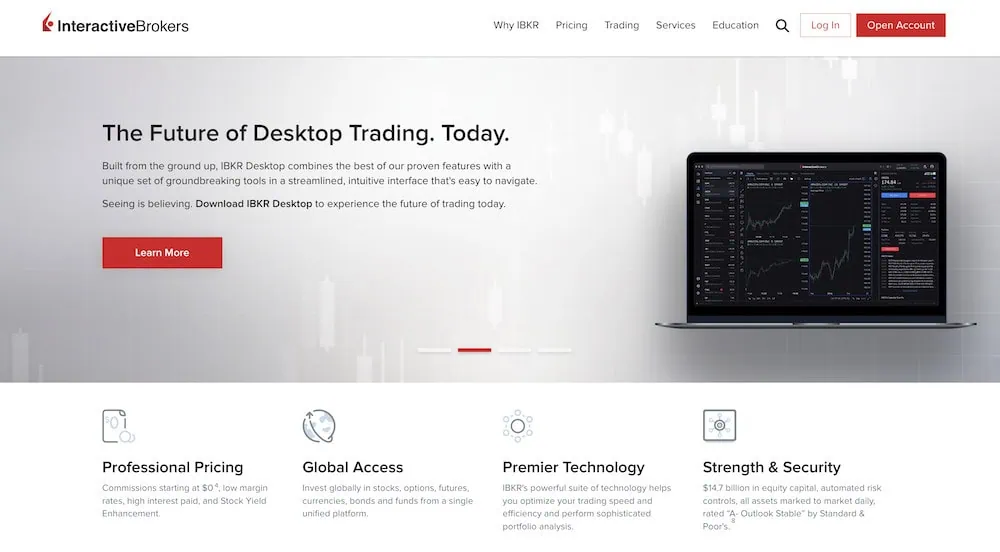
- Available: Sign up here
- Platforms: Desktop (PC, Mac), web, iOS, Android
- Best for: Intermediate and advanced investors
Interactive Brokers (IB), founded in 1978, is the largest U.S. electronic trading platform, offering traders access to stocks, bonds, funds, options, cryptocurrencies, foreign exchange, futures, and more.
Costs are a significant advantage for IBKR. Commissions start at $0 for U.S.-listed stocks and ETFs, and commissions are generally low on other products. IBKR also has no account minimums, ticket charges, or added spreads. Day traders will especially love professional-level pricing, which lets investors lower their costs to maximize their returns, as well as margin rates that are up to 51% lower than the industry.
IBKR’s Trader Workstation (TWS) is Interactive Brokers’ flagship desktop program—a trading platform with roots back to 1995. But since then, the company has launched a number of other access points for brokerage accounts, including:
- IBKR Desktop: This desktop trading platform combines the most popular tools from its flagship Trader Workstation (TWS) with new tools such as a powerful MultiSort screener and Options Lattice, as well as a growing suite of original features suggested by IBKR clients.
- IBKR Mobile: A powerful app for iOS and Android that allows people to trade on the go
- IBKR GlobalTrader: A simplified app for iOS and Android that targets global traders, allowing deposits in up to 23 different currencies
- Client Portal: A lighter web-based platform allowing clients to manage their account, evaluate performance, and read market news
- IBKR EventTrader: A web-based platform allowing investors to trade “event” contracts (yes-or-no questions like “Will the S&P 500 Index close above 6,400 today?”)
- IBKR Impact: A mobile app that helps investors select holdings most in line with their values.
But Workstation remains the workhorse. The trading platform supports investments across 150 global markets, and offers a wide variety of features, including real-time monitoring, risk management tools, paper trading—all packaged under a heavily customizable layout day traders can use.
While TWS users can still select the original view, they can build their own bespoke view through Mosaic. Functions such as stock monitoring, order entry, charts, and more appear as “tiles,” sized and arranged however you want them, and you can save custom layouts designed for one or more monitors.
Trader Workstation also lets investors:
- Create example watchlists
- Use preset scans or build your own
- Create real-time trading alerts using price, time, margin, and volume
- Access more than 100 order types and algorithms to execute better trades
- Read breaking news from Reuters, Dow Jones, and other news outlets
- Access research from Morningstar, Zacks, and other firms
IBKR Lite/IBKR Pro
Interactive Brokers offers two primary plans—IBKR Lite and IBKR Pro—and both have no account minimums and zero maintenance fees. They also provide investors with access to many of the same features, including the Client Portal, Trader Workstation, and IBKR Mobile platforms; advanced order types; fractional shares of U.S. and European stocks and ETFs; paper trading; and Risk Navigator, which evaluates your risk in single positions or across your entire portfolio.
IBKR Lite is most suitable for beginner and intermediate investors, offering unlimited commission-free U.S.-listed stock and ETF trading, and fixed pricing for non-U.S.-listed stocks and ETFs, mutual funds, options, and futures.
IBKR Pro, meanwhile, is meant for advanced investors and active traders. While it does charge commissions on even U.S.-listed stocks and ETFs, it provides better execution for trades via its IB SmartRouting, which seeks out the best available prices for stocks and options across exchanges and dark pools.
Pro also offers some features not available on IBKR Lite, including higher interest paid on idle cash balances, lower interest charged on margin loans, backtesting, and access to IBKR APIs, which allow you to build your own custom trading applications and even develop commercial trading software—features often used by hedge funds, Registered Investment Advisors (RIAs), and proprietary trading firms.
You can visit Interactive Brokers to sign up or learn more.
- Trade stocks, bonds, ETFs, mutual funds, options, cryptocurrencies, foreign exchange, futures, micro futures, and futures options using the powerful legacy Trader Workstation desktop software or IBKR's web and mobile platforms.
- No account minimums, no maintenance fees with both IBKR Lite and IBKR Pro.
- Commission-free stock and ETF trading with IBKR Lite.
- Optimized trade execution and higher interest on cash balances with IBKR Pro.
- Access features including watchlists, preset or customized stock scans, real-time trading alerts, advanced order types, and news and research from numerous leading providers.
- Excellent selection of available investments
- Extremely feature-rich desktop (Trader Workstation) and app (IBKR Mobile) platforms to satisfy even the most advanced traders
- Below-average options contract fees
- Trader Workstation Mosaic view is versatile and highly customizable
- Robo-advisory services are available through Interactive Advisors
- Mobile app experience could be smoother
4. Robinhood (Best Simple Stock Trading App for Beginners)

- Available: Sign up here
- Best for: Beginner traders
- Platforms: Web, mobile app (Apple iOS, Android)
Robinhood has become a mainstay for younger investors and traders alike, and it has enough features to make it an acceptable offering for budding day traders.
Over the years, Robinhood has added a boatload of features for new and experienced investors alike. Advanced Charts, for instance, provides simple and customizable charts with a variety of technical features. Robinhood’s Options Strategy Builder simplifies the options-trading process by helping you build a strategy based on what you expect your target stock or ETF will do in the future. Robinhood also offers 24/7 commission-free cryptocurrency trading with Robinhood Crypto (though you’ll still have to pay a spread), allows extended-hours trading, and lets users earn interest through stock lending.
Robinhood does offer a paid subscription service—Robinhood Gold—with several more features mostly geared toward advanced traders. Benefits include Level 2 market data provided by Nasdaq, a lower charged rate on margin investing than regular accounts, higher interest on uninvested brokerage cash via the cash sweep program, and bigger Instant Deposits.
Even at the Gold level, Robinhood doesn’t offer some advanced trading features, such as a price ladder, direct market routing, advanced orders, and backtesting. But it’s still one of the best choices for aspiring traders looking to get their feet wet.
Sign up for a Robinhood brokerage account today.
- Robinhood is a pioneer in the investing app world, offering commission-free trades on stocks, ETFs, options, and cryptocurrency, as well as one of the deepest libraries of investing educational content.
- Investing for retirement? Robinhood will match 1% of any IRA transfers or 401(k) rollovers, as well as any annual contributions*, made to your Robinhood Retirement account—and you can get a 3% match on any new contributions if you subscribe to Robinhood Gold.
- Want more advanced trading tools? Download Robinhoold Legend—a desktop trading platform with real-time data, customizable layouts, deeper asset analysis, and more—for free.
- Robinhood's robo-advisory service, Robinhood Strategies, will build you a custom portfolio of stock and bond ETFs (and individual stocks for accounts with at least $500), for a low 0.25% in AUM, which is capped at $250 annually for Robinhood Gold members.
- Robinhood Gold also includes Level II market data provided by Nasdaq, higher interest rates on uninvested brokerage cash, lower margin trading rates, bigger Instant Deposits, and access to the Robinhood Gold Card (a 3% cash-back Visa credit card).
- Special offer: Sign up for Robinhood, link a bank account, and fund your account with at least $10, and receive a randomly selected cash amount between $5 and $200 to put toward certain fractional shares.
- Very good selection of available investments in brokerage accounts
- 1% match on rollovers, IRA transfers, and new contributions to IRAs and Roth IRAs (3% new-contribution match with Robinhood Gold)
- Automated recommended portfolios
- Intuitive interface
- Robo-advisory service (Robinhood Strategies)
- Extensive educational library
- No mutual funds in brokerage or IRAs
- Match doesn't apply to Robinhood Strategies accounts
5. NinjaTrader (Best for Technical Analysis Tools and Free Paper Trading for Beginners)
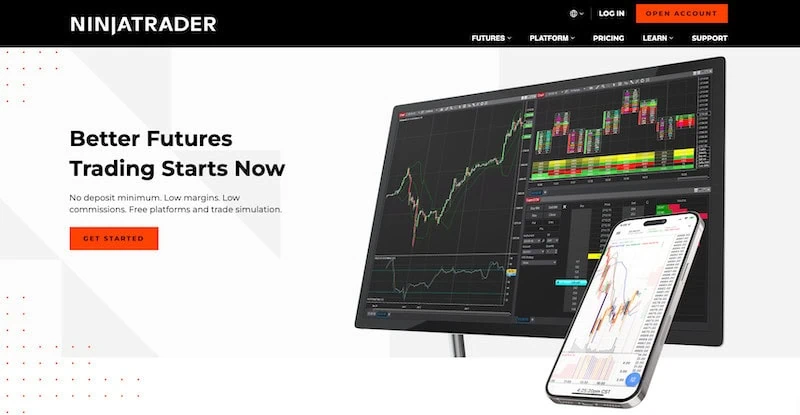
- Available: Sign up here
- Best for: Active traders specializing in day trading futures and forex (and other assets through third party brokers)
- Platforms: Desktop app (Windows), web, and mobile app (iOS and Android)
NinjaTrader is one of the oldest and best known trading platforms on the market.
Specializing in technical analysis tools, real-time analysis, and a clean, fully customizable charting experience, NinjaTrader allows you to employ a fully automated trading strategy through its own brokerage service for futures, options on futures, and forex trading. And while that might seem like a limited set of assets, NinjaTrader’s other core strengths are its ability to integrate with other brokers like IBKR, Schwab (TDAmeritrade), and others for an add-on fee and its NinjaTrader Ecosystem.
This community of vendors and plugins enrich the NinjaTrader experience through offering education-rich content for free and, among other things, allows you to attach NinjaTrader to several supporting brokerages to give traders access to other markets, including options on futures, contracts-for-differences (CFDs), and equities.
NinjaTrader’s platform offers advanced charting with more than 100 technical indicators, advanced order types, automated trading, order flow analysis, streaming historical market replay, the SuperDOM (depth of market) tool, and more. The NinjaTrader desktop app is the most customizable of the platform’s versions, offering access to “thousands of trading apps and add-ons,” you can still enjoy most of NinjaTrader’s functions via its web and mobile apps.
Unfamiliar with futures trading? Anyone with an account can use NinjaTrader’s free futures trading simulator, which includes a backtesting engine that lets you use historical market data to simulate automated trading strategies and see how they would have performed.
You can download and use NinjaTrader’s platform for free, but you can reduce your commissions by subscribing to a monthly or lifetime account. Additional data does carry additional costs, however. For instance, for CME Level I top of book data (CME, CBOT, NYMEX, and COMEX), it’s $12 per month and Level II costs $41 per month for non-professional users. Professional users pay $135 per month per exchange. ICE Market data also costs $140 per month per exchange for all users.
NinjaTrader’s robust community and suite of tools have established it as a leading charting software—be it for stocks, futures, forex, or other assets. The burgeoning educational guides, video library and free ongoing webinars provide ample access to the understanding traders need to hone their craft. Plus, the platform offers an easy (and free) way to learn what the platform can offer through its SIM trading environment. Consider signing up for a NinjaTrader account and taking the service for a test-drive.
- NinjaTrader is a brokerage account offering access to futures and forex directly, and several other asset classes through integration with third-party brokers.
- The robust charting tools, technical analysis capabilities, and real-time full depth of market data empower active traders to make informed decisions.
- The NinjaTrader Ecosystem offers access to thousands of vendors and plugins and includes a comprehensive educational offering for traders to improve their understanding and execution of trades.
- NinjaTrader offers a free SIM trading environment designed to employ what you've learned from their ecosystem's educational content without risking your own money.
- If you open and fund a NinjaTrader account, you'll receive up to $250 in commission rates for trades placed within 30 days of your funding date.**
- Excellent charting and technical analysis tools
- Partial and full strategy automation
- NinjaTrader Ecosystem offers apps and add-ons
- Free SIM trading environment suitable for beginners
- Robust educational guides, videos and webinars
- Trading equities requires using a supporting broker
6. CIBC Investor’s Edge (Flexible Broker With Transparent Fees for Canadians)
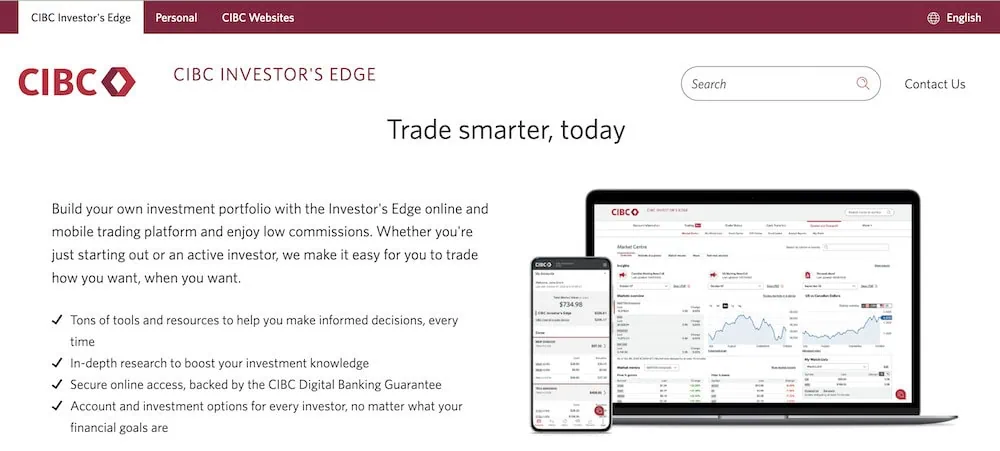
- Available: Sign up here
- Best for: Beginner to intermediate Canadian investors
- Platforms: Web, mobile app (Apple iOS, Android)
CIBC Investor’s Edge is a workhorse online broker that provides a satisfying experience for Canadian investors across the proficiency spectrum while charging relatively modest and transparent fees.
Investor’s Edge allows you to trade not only U.S. and Canadian stocks and ETFs, but also options, mutual funds, and bonds. And you can do so from non-registered accounts, as well as a variety of registered accounts, including FHSAs, TFSAs, RRSPs, RESPs, and more.
The Investor’s Edge platform also provides a variety of screening and charting tools, analyst reports, customizable watchlists and alerts, Regular Investment Plans, and more. You can also stay informed and up to date through CIBC’s investor learning center—which includes topics such as Investing 101, How to Trade Options, and (as you’d expect) how to trade using the Investor’s Edge platform—as well as expert videos and webinars, and various newsletters.
Note that, in addition to flat commission fees (listed below), CIBC Investor’s Edge does sometimes charge an account fee. Specifically, you’ll pay $0 when the balance of all CIBC Investor’s Edge accounts is greater than $10,000, but $100 annually if the balance is $10,000 or less. That said, CIBC requires no minimum account balance.
And CIBC is a screaming deal for younger investors. Anyone ages 18 to 24 can start trading stocks and ETFs online for free—no annual fee, and no commissions—if they first open a CIBC Smart Account with CIBC Smart Start.
Whether you’re looking to get started, or are an experienced investor who just wants to lower their commissions, look into CIBC Investor’s Edge today.
- CIBC Investor's Edge is a straightforward, easy-to-use brokerage platform that allows access to a variety of investments—including stocks, ETFs, options, mutual funds, bonds, and more—at reasonable and transparent costs.
- Modest commissions. U.S. and Canadian stocks, ETFs, and mutual funds: $6.95 per trade for investors (150 or fewer trades per quarter); $4.95 per trade for active traders (150+ trades per quarter). Money market mutual funds: $0. Mutual funds: $6.95. Options trades also include a $1.25 contract fee.**
- Available account types include: Non-registered, FHSA, TSFA, RRSP, RESP, RRIF, LIRA, LRSP, LRIF, PRIF.
- Suite of investing and trading tools includes screening, charting, watchlists, alerts, news, education center, and more.
- Special offer: Use promo code EDGE100 to get 100 free online stock and ETF trades when you open a CIBC Investor's Edge account.***
- Very good selection of available investments
- Large selection of registered accounts
- Modest commissions
- No minimum account balance
- Trading tools not as advanced as many other competitors' offerings
- $100 annual fee for low-balance accounts
7. Moomoo (Advanced Stock Trading App With Low Margin Rates)
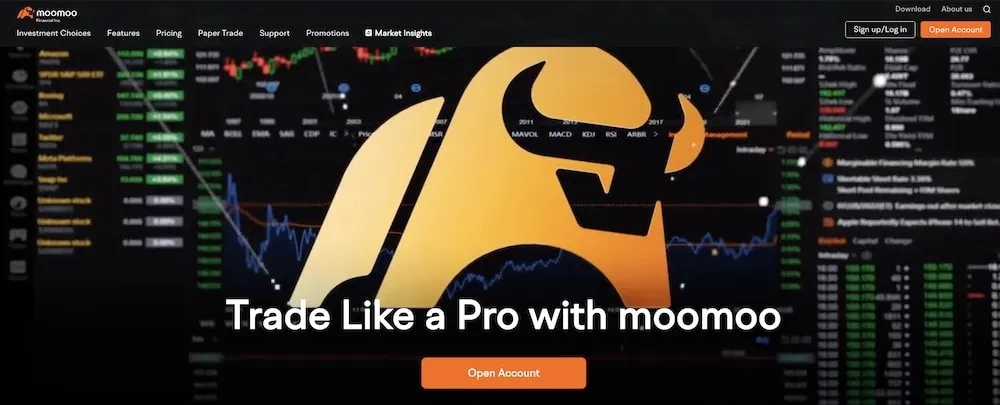
- Available: Sign up here
- Best for: Advanced traders
- Platforms: Desktop app (Windows, Mac), web, mobile app (Apple iOS, Android)
Moomoo is a commission-free trading platform for stocks, ETFs, and options. While Moomoo is best for advanced traders, offering powerful tools to empower your trading insights and strategies, it takes a different approach from other similarly targeted platforms, favoring simple interfaces and high ease of use. The desktop platform is highly customizable, while the mobile app is straightforward, allowing you to search for stocks and trade with minimal hassle.
Still, Moomoo has more than enough under the hood for advanced traders to get the job done. Its charting system, for instance, includes 62 technical analysis indicators and 22 drawing tools. You can set up alerts based on changes in price, bids, turnover ratio, and more. Free Level 2 market data helps you get a greater understanding of a stock’s value, determine how liquid a stock truly really is, and better time your trades. You can even enjoy 24/7 financial news handpicked by Moomoo’s editorial team. The trading platform provides these features to empower investors to make better investing decisions.
One Moomoo feature worth noting is its mobile charting, which allows traders to take advantage of more than 60 investing indicators and 38 drawing tools. And any drawings or annotations you make are saved and synced with your profile so you can view them from either the app or your desktop.
While Moomoo isn’t as suitable to beginner traders, the trading platform does include some useful educational tools. For instance, paper trading functionality with real-time data simulates the investment experience without committing any of your real money. (This feature is also helpful to advanced traders, allowing them to test out strategies and hone their skills.)
Moomoo also boasts relatively low rates for trading on margin. The annualized interest rate on financing, as of this writing, is 6.8%—one of the most competitive rates among its peers.
The app pays you for giving it a spin by offering free stocks when you make a qualifying deposit after signing up. Specifically, you can get free stocks if you sign up for a Moomoo account and make a qualifying deposit.
If you want a professional-grade system for research and trading, but with a simpler user experience, Moomoo is among the best trading platforms to consider.
- Moomoo is an all-in-one investment app geared toward stock, ETF, and options traders who want to work with real-time market data at the ready.
- The service offers free Level 2 market data, offering more insight into the trading activity below the NBBO surface shown on many financial data sites.
- Use the service's powerful stock charting software capabilities to find trading opportunities.
- Get a great return on uninvested cash: Moomoo currently offers a 4.1% APY from its cash sweep program, though current promo offers 8.1% for a limited time.
- Special offer: New users get up to $1,000 in free NVDA stock when they sign up using our link and make a qualifying deposit,* as well as a three-month APY boost (to a total 8.1% APY on uninvested cash).
- Additional special offer for transfers: New customers who transfer assets into a Moomoo account can also receive a 3% match on their transfer up to $20,000 (for a reward cap of $600). New users who transfer in $50,000 or more and maintain for three days will also receive two suite tickets to a New York Mets game.
- Free Level 2 market data
- Free powerful stock charting software
- Free paper trading
- Low margin rates
- Fewer features than peers
- No robo-advisor functionality
8. TradeStation Select (Best Day Trading Platform for Programming-Savvy Day Traders)
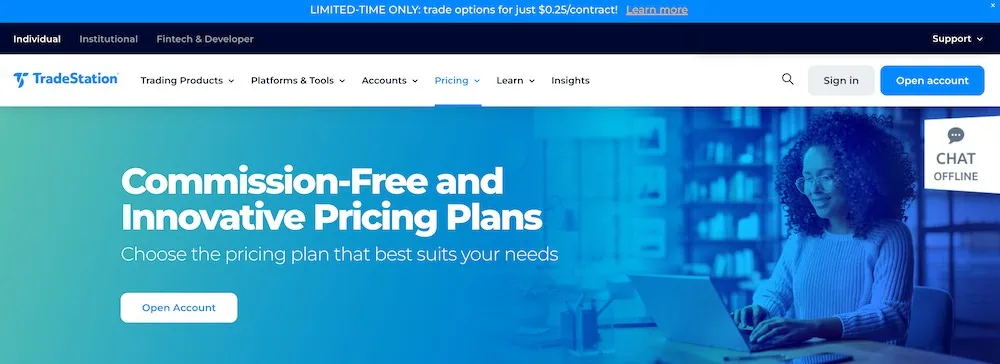
- Available: Sign up here
- Best for: Advanced traders, options and futures traders, active stock traders
- Platforms: Desktop app (Windows), web, mobile app (Apple iOS, Android)
TradeStation Select is a powerful day trading system that includes a full-featured desktop app, a robust web trading platform, and a highly rated stock trading app—all of which include numerous tools for day trading stocks that are useful to day traders.
Much like almost every other online discount broker found on our list, this free stock trading app helps traders avoid commissions. Specifically, TradeStation offers zero commissions on stocks, exchange-traded funds, options, futures, micro futures, and futures options. It also functions as a direct access trading platform, meaning it connects traders directly with market makers or specialists on the trading floor like the New York Stock Exchange, further helping to lower spreads and the costs of your trades.
But the reason traders opt for TradeStation isn’t just the cost—well, lack of it—but its advanced trading features and services.
What makes TradeStation different?
TradeStation is one of the most high-powered stock trading platforms on this list. That’s because opening a TradeStation brokerage account provides you with free access to the TradeStation Analytics platform, which includes advanced trading tools such as:
- Matrix: TradeStation packs market depth, advanced order entry, and order tracking all in a single window, then combines it with one-click trading and extremely fast order execution. TradeStation calls it the “Swiss Army Knife of trading tools,” and it’s an apt description based on our in-depth experience reviewing these day trading platforms.
- RadarScreen: Identify trading opportunities with RadarScreen, a real-time screener that can monitor as many as 1,000 tickers. You can also use RadarScreen to rank those stocks based on your own custom criteria, or based on more than 180 preset (but customizable) fundamental and technical indicators.
- OptionStation Pro: This app provides a more visually appealing, and easier-to-understand, method of exploring the options markets. You can build option chains, model options positions with 3D graphics, and quickly place your trades.
- EasyLanguage: Want to take your trading to the next level? Create your own trading tools, indicators, even applications, with this trading-focused programming language—a language TradeStation already uses in every one of its indicators, strategies, and user functions.
(Note: Even if you don’t use TradeStation as your trading platform, you can still access TradeStation Analytics for $99 per month if you’re a non-professional trader, or $199 per month if you’re a professional trader.)
Other day trading features include a simulated trading mode that allows you to test out trading plans without putting your funds at risk, backtesting, price ladder, direct market routing, and customizable charting. Level 2 data for equities is available for $11 per month.
A passive feature of note is the Fully Paid Stock Lending Program. Through the program, you can allow TradeStation to lend out fully paid or excess margin securities, and in exchange, they’ll pay you a portion of the interest TS earns each day.
Other considerations
TradeStation is one of the best brokers for day trading, but even experts might need a hand every now and then—and less experienced day traders very well might need assistance. Fortunately, TS offers personalized support from the company’s brokerage professionals.
While TradeStation is commission-free, it’s hardly cost-free. For instance, all stock options trades still require a 60-cent contract fee. Futures trades are charged $1.50 per contract per side, micro futures trades are charged 50 cents per contract per side, and futures options are charged $1.50 per contract per side. Margin rates, currently in the double digits, are high compared to peers based on the findings of our review at the time of this writing. And mutual fund fees are a steep $14.95 per trade—no big deal for day traders, who likely would avoid them anyways, but a hurdle for anyone looking to buy and hold mutual funds in their TS account.
And let’s be clear: Beginning traders could be overwhelmed by this service, which caters to extremely active and experienced day traders who use day trading platforms like TS primarily for its research tools and advanced trading tools.
Regardless, TradeStation’s top-of-class trading tools (and a wide variety of ways to access them) makes it one of the best stock trading platforms for advanced traders on our curated list. Intermediate users should be able to make plenty of hay on this platform, too. So if you’re interested, visit TradeStation to sign up for an account or get more information.
- TradeStation is a powerful trading platform that allows you to invest in a wide array of products, including stocks, ETFs, mutual funds, options, bonds, forex, futures, micro futures, and futures options. You can also participate in IPOs.
- The platform comes equipped with trading and investing tools that are useful to seasoned professionals and new traders alike. Identify trading opportunities, explore option markets visually, even create your own trading tools with TradeStation's proprietary programming language.
- TradeStation's brokerage services and trading education resources are recognized by respected industry reviewers.
- Excellent selection of available investments
- Professional trading features and capabilities
- Intuitive trading interfaces and tools
- Competitive pricing for trading volume
- Varied and confusing fees for specific actions/events
- Mac users can only run TradeStation desktop platform through a Windows emulator
9. eToro (Best Day Trading Platform for CopyTrading)
- Available: Sign up here
- Best for: Intermediate traders
- Platforms: Desktop app (Windows, macOS), web, mobile app (Apple iOS, Android)
Most trading apps keep you in one place: Your account. But eToro wants to change that.
eToro has made investing social by giving you the chance to engage with other traders, creating a social trading network designed to share ideas on the publicly traded markets. You can trade stocks, exchange-traded funds (ETFs), and options commission-free, and you can also get exposure to cryptocurrencies.
eToro is known for its CopyTrader service—a novel product that allows you to copy the trades of experienced investors automatically. No more guesswork on making trades yourself; you simply follow the leader and let the app handle the legwork for you. While this might not interest advanced traders, it’s an appealing feature for moderately experienced traders looking to replicate the performance of popular traders on the platform. (Editor’s Note: Even though this can make for a fun trading experience, you should still be fully aware of the risks entailed through this feature—namely, the potential for losses.)
More experienced day traders might bemoan the lack of several important features, including Level 2 quotes, backtesting, price ladder, and direct market routing, and you can only use advanced orders through crypto trading. (Popular traders who allow themselves to be copied by others on the platform can earn income, rewards and perks from eToro through participating in the CopyTrader program.)
Of course, you don’t have to copy anyone—you can trade on your own ideas. This intuitive investing app began with a strong crypto focus, but you can now make self-directed trades across a host of other assets.
The trading app offers access to dozens of cryptocurrencies, hundreds of ETFs, and thousands of stocks. When you trade crypto with the platform, you’ll encounter what we’ve found to be an industry-standard spread of 1%. Of particular interest to options traders, eToro charges no options contract fees in the U.S. (but it does levy a $0.65 fee per option contract in the U.K.). Investors can also use the app to understand environmental, social, and governance (ESG) scores through their user-friendly “traffic light” color scheme: green means the company is a leader in its sector, yellow indicates average, and red means the company scores poorly relative to sector competitors.
Lastly, if you’d like to invest based on a specific theme or strategy, eToro offers Smart Portfolios. These are fully allocated, balanced portfolios, investing in various market segments, that are backed by professional research and various risk management rules. You only need $500 to participate in Smart Portfolios, and you pay no management fees.
And for people interested in testing the waters without opening their wallet at the start, eToro offers a free demo account that comes with $100,000 in virtual money to test your trade ideas.
Opening an account is quick and simple to do. Simply visit eToro’s website to open and fund an account.
- The eToro trading platform allows you to buy and sell stocks, ETFs, and options with 0% commission, including no contract fees on options.
- Trade dozens of the most popular cryptocurrencies.
- Not sure what kind of trading strategy you want to employ? eToro allows you to replicate the trades of popular traders automatically, in real time.
- Test out your strategies with eToro's $100,000 practice account.
- $100 minimum deposit to get started.
- Special Offer: Get $10 when you deposit $100 or more.*
- Good selection of available investments
- No options contract fees
- Fractional shares
- Copy trading functionality
- Strong technical analysis tools available
- $100,000 virtual portfolio included for free
- Charges withdrawal fee ($5)
- Doesn't offer robust fundamental tools
- Unavailable in 4 U.S. states (NY, NV, HI, and MN)
10. Webull (Ideal for Intermediate Investors + Traders)
- Available: Sign up here
- Best for: Self-directed investors and intermediate traders
- Platforms: Desktop app (Windows, macOS, Linux), web, mobile app (Apple iOS, Android)
Webull first hit the investing world in 2018 and made a splash by offering free stock trading, as well as commission-free trading of ETFs and options. And since then, it has become one of the best stock apps for intermediate traders and investors, though many of its features are helpful to beginners as well.
For one, Webull remains friendly to wallet-conscious traders today. It costs nothing to open a Webull account. Stocks, ETFs, and options still trade without transaction fees. Many options have $0 contract fees. And Webull has no deposit minimums. On top of that, it offers fractional shares, which allows investors to start buying for as little as $1. So beginners working with small dollar amounts can still easily diversify across numerous investments.
Newer investors can also learn trading skills through the courses in Webull’s education center, and even practice their skills via Webull’s paper trading service. (I’ve personally used this service and will admit practicing my trades here has saved my family and I many thousands of dollars by virtue of having the losses only exist virtually. My wife never needs to know the fictitious fortunes I’ve managed to lose for us time and time again.)
And if you wondered whether you could access Webull on your personal devices, Webull is available across just about every platform, allowing you to research, trade, and track your stocks on your smartphone, tablet, or desktop.
Why choose Webull to trade stocks?
Webull provides investors with several useful features and tools, including:
- Customizable screeners for both stocks and ETFs
- Preset lists–including Top Gainers, Top Losers, Most Active, and Best-Performing Industries—investors can use to identify opportunities
- Voice commands: Simply speak to buy, sell, or look up information about a ticker
- “Big Button Mode”: Populates giant buttons on your screen that allow you to quickly make trades with just a push.
- Charting tools
- Free real-time stock quotes and stock alerts
If you want to step up your trading game, Webull offers one month of free Level 2 quotes from Nasdaq TotalView, followed by a cheap subscription cost of just $1.99 per month. Webull also has advanced orders and a price ladder, though it lacks backtesting and direct market routing.
We’ll point out that while Webull allows for many types of commission-free trades, other costs will still apply to a few transactions. For instance, a 55-cent contract fee applies to certain options trades. And Webull doesn’t directly charge fees for trading cryptocurrencies; however, it does build a 1-percentage-point markup into the price of cryptocurrency when you buy or sell crypto—a benchmark we’ve found many brokers charge for the asset class.
One particularly noteworthy shortcoming for investors is that you can’t buy mutual funds on Webull. Yes, ETFs offer a wide array of diversified strategies, but the mutual fund world offers some cheap index funds and many successful actively managed strategies.
Regardless, Webull remains one of the best, and most cost-friendly, trading platforms you can come across. And on top of all the free features mentioned above, Webull also runs frequent promotions that allow investors to collect free stocks.
If you’re interested, sign up at Webull today.
- Webull is a low-cost trading and investing app that allows you to invest in stocks, ETFs, options, futures, commodities, and crypto, and even participate in initial public offerings (IPOs).
- No-commission stock, ETF, and option trades (and many options have $0 contract fees).
- Trading features such as charting tools, technical indicators, customizable screeners, real-time stock alerts, and group orders.
- Let Webull manage your money for you with Webull Smart Advisor, which combines Webull's in-house investment expertise and artificial intelligence to build, manage, and rebalance an ETF portfolio for you.
- Sign up for Webull Cash Management to earn up to a 4.1% APY.*
- New users get one free month of Nasdaq TotalView's Level 2 Quotes service. (That subscription costs $2.99/mo. thereafter.)
- Subscribe to Webull Premium and receive a premium APY on uninvested cash in individual and joint cash accounts, premium margin rates, a 3% match when you transfer or roll over your IRA, and an extra 3.5% match on qualifying IRA contributions.
- Special offer: Make an initial deposit of at least $2,000 and receive 1.) a $100 cash bonus, 2.) a 2% match of your deposit (up to a maximum bonus of $20,000), 3.) a 30-day voucher for Webull Premium, 4.) a 30-day 4.0% APY booster on uninvested cash (for a total of 8.1%).**
- Good selection of available investments
- Fractional shares
- Powerful technical analysis tools
- Offers robo-advisory services
- Accessible to beginning and intermediate users
- Voice commands
- Offers highly competitive APY through Webull Cash Management
- Does not support mutual funds
11. Tastytrade (Free Live Trading Video Feed)
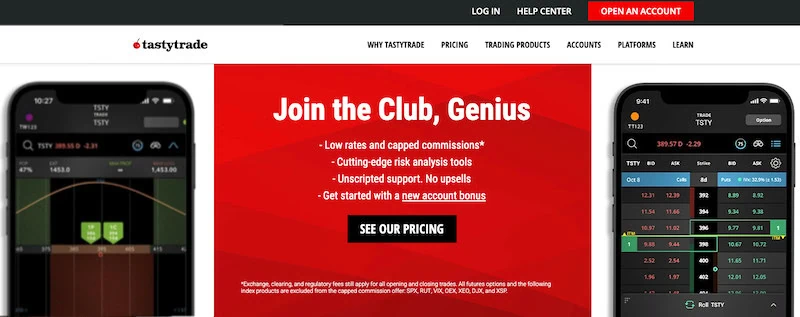
- Available: Sign up here
- Best for: Day traders, options and futures traders, active stock traders
- Platforms: Desktop app (Windows), web, mobile app (Apple iOS, Android)
Tastytrade is an award-winning, self-directed brokerage started by the original founders of the famous thinkorswim trading platform, which was purchased by TDAmeritrade and subsequently bought by Charles Schwab.
The service offers competitive commissions on the usual suspects: stocks and ETFs, but also on options ($1/trade on stock and ETF options), futures, options on futures, commodities, indices and cryptocurrencies (1% commission on trade volume up to a $10 cap).
The platform offers the chance to experience cutting-edge, game-changing technology that anticipates next generation needs from traders. And one of the ways Tastytrade excels is their charting tools. They’re robust, interactive tools with over 250 available technical studies traders can use to analyze price and volume action in securities they follow. Traders can detach chart windows from the main trading screen to spread across a multi-monitor setup to keep eyes on several securities at once. Further, the stock charts allow for near endless customization so each trader can have the individual setup best suited to their needs.
The service aims to fix “trader’s block,” or the trader’s equivalent to writer’s block. It offers the ability to track traders on the platform and engage in video-feeds with other people to discuss all things markets. The service also partners with Tastylive, a financial news network entirely focused on talking shop about trading. Tastytrade says the services, when combined, can “transform you from a timid beginner to a confident, everyday trader.”
If you’re new to Tastytrade, they have ongoing incentives to make signing up for an account worthwhile. Learn more by visiting the Tastytrade site, opening an account and seeing if the trading platform’s stock charts handle your needs.
FAQs About the Best Day Trading Platform Options
What Is day trading?
First, a quick primer for the uninitiated:
Day trading involves making intraday trades to try to profit off short-term movements in stocks, exchange-traded funds (ETFs), options, currencies, and other assets. Day traders employ a number of trading strategies; a few examples include:
- Momentum: Chasing stocks making big price moves
- Pullback: Trading stocks that are in a longer-term uptrend but have temporarily pulled back in price
- News: Trading based on news events, such as earnings announcements or product reveals
Technically, if you even make one trade where you buy and then sell (or sell and then buy) the same security within a trading day, you’ve been engaging in day trading. But there’s also an important day trading designation—a “pattern day trader” (PDT)—that many brokerages use to identify riskier traders. From the Financial Industry Regulatory Authority (FINRA):
“You’re considered a pattern day trader if you execute four or more ‘day trades’ within five business days—provided that the number of day trades represents more than 6 percent of your total trades in the margin account for that same five business day period.”
Pattern day traders must hold at least $25,000 in their margin accounts (or more depending on a brokerage firm’s own requirements), and face other regulatory limitations, too.
Just go into it with your eyes wide open: More often than not, day traders lose money. Ritholtz Wealth Management’s Ben Carlson provided some disheartening statistics on the dangers of day trading in a post on his A Wealth of Common Sense blog. Among them:
“Research on individual day traders in Taiwan over a 15-year period from 1992 to 2006 showed even the most experienced day traders lose money, and surprisingly even those traders who lose consistently continue to trade despite their losses. … Another study of eToro day-traders found nearly 80% of them lost money over a 12-month period with a median loss of 36%.”
But if you’re still up for day trading, and you’re well aware of (and capable of handling) the risks, the best thing you can do is arm yourself with the technology you need.
What is a pattern day trader?
As we mentioned above, FINRA defines a pattern day trader (PDT) as someone who has executed four or more day trades within five business days, as long as that number represented more than 6% of total trades from their margin account over the period.
Does the SEC have special rules to trade stocks intraday?
FINRA, not the Securities and Exchange Commission (SEC), established the rules on day trading. FINRA requires pattern day traders to have at least $25,000 of equity (cash and eligible securities) in their margin accounts to participate in day trading. If the equity in a margin account falls below that, the trader must stop day trading until the equity returns above that threshold. PDTs also can’t trade in excess of their day-trading buying power (usually up to four times the maintenance margin excess).
Why do you need $25,000 to day trade?
The $25,000 requirement acts as a cushion for your brokerage firm. While trades might appear closed in your brokerage account, they might take more time to actually settle. The $25,000 buffer protects the brokerage firm from any deficiencies in your account that might occur as these day trades settle.
Can you day trade without $25,000 in your account?
If you are a pattern day trader, no, you cannot. If you are not a pattern day trader, you can execute day trades without $25,000 in your account as long as you don’t hit the threshold for being labeled a pattern day trader.
Can you start day trading with $1,000?
Yes. Day trading is only defined by buying then selling (or selling then buying) a security within the same trading day. In some cases, just a few dollars is enough to complete a day trade.
Is day trading still profitable?
Day trading can absolutely be profitable, but the odds are not in your favor. Numerous studies have shown that the majority of day traders lose money, and that those losses can be significant. Your best bet: Find a top online broker for day trading so you at least have the tools you’ll need to succeed.






